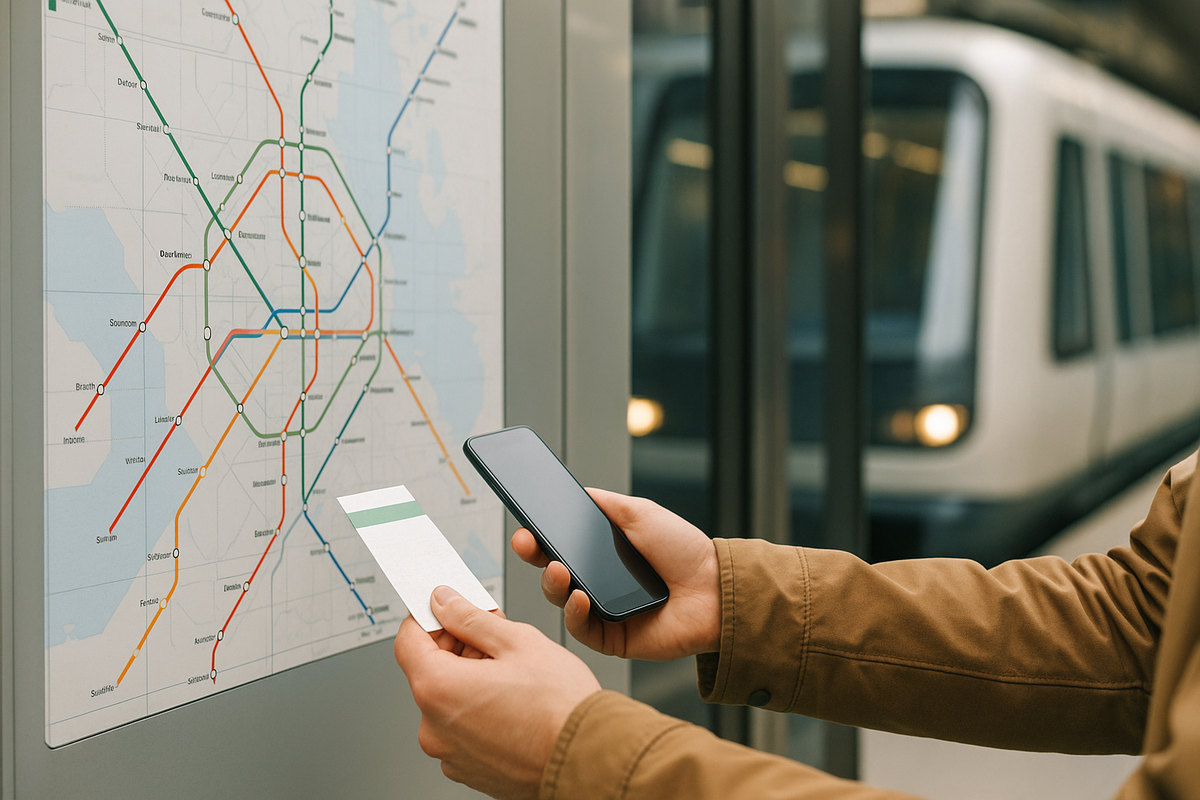🚇 Transport in Copenhagen: comparison of prices for the metro, trains, CityPass and Rejsekort
Copenhagen itself is quite compact, but the fare system seems complicated even when buying your first ticket: zones, different types of passes, separate apps and cards.
Tourists often overpay not because of high prices, but because of the wrong choice between CityPass, single tickets and Rejsekort. At the same time, the whole system is quite logical: everything is built around zones, and one ticket covers the metro, trains, S-train, buses and even the harbour bus.
In this article, we will break down how the zones are organised, how the ticket formats differ and which option is more profitable in typical scenarios for a 2-5 day trip.
🚆 How zones and tickets work in Copenhagen

Copenhagen's transport system only seems scary for the first 10 minutes 🙂. Once you understand the logic of the zones, everything falls into place: one ticket covers all types of transport within the paid zones.
🗺️ The zone system — what tourists need to know
- The entire area (Zealand + nearby islands) is divided into zones.
- The centre of Copenhagen is zone 1, surrounded by zones 2, 3, 4, etc.
- Kastrup Airport is zone 4, so a trip from the airport to the centre = 3 zones (1–4).
- Tickets are always purchased for N zones (minimum 2). During the period of validity, you can:
- travel by metro, train, S-train, bus, harbour bus;
- change trains as many times as you like, as long as the time has not expired and you have not travelled outside the paid zones.
Conventionally, the classic logic for tourists is:
- in the city centre (1–2, sometimes zone 3) → a 2-zone ticket is sufficient;
- to/from the airport (1–4) → you need a ticket for at least 3 zones.
🎟️ Single ticket
You can buy a single ticket from a ticket machine/app for a specific number of zones.
- Valid for a limited time (usually 1–1.5 hours — the more zones, the longer the validity period);
- Allows you to make transfers within the paid zones while it is valid;
- Convenient if: you make 1–2 trips a day, or just need to get from ‘A → B’ and then walk further.
💡 Rule: if you have many short trips + airport during the day, simple single tickets quickly cease to be profitable — it makes sense to look towards CityPass.
🎫 Basic tickets: when a single ticket is enough

Not everyone needs a travel card. For some tourists, correctly purchased single tickets are the simplest and most honest option.
✅ When a single ticket is the right choice
- 🕰️ 2–3 days in the city, based in the centre, you: walk a lot, only use transport for a couple of trips: airport, one trip to a remote area, return in the evening.
- You don't like to overpay for ‘unlimited’ if you know in advance that you won't be travelling all day.
- You are travelling alone or as a couple and are willing to buy a ticket from a machine/app each time.
An example of a typical day with single tickets: in the morning: metro/train from your neighbourhood to another part of the city; during the day: everything on foot; in the evening: return trip; total: 2 trips — a single ticket by zone is logical.
⚠️ Where people most often lose money with single tickets
- They buy 3–4 single tickets per day + separately ‘airport → centre’ and ‘centre → airport’ — the total cost is more expensive than a CityPass for a day.
- They buy a ticket for the wrong number of zones:
- trying to get to the airport with a 2-zone ticket (formally invalid);
- overpaying for 4–5 zones, even though the actual route is 2–3 zones.
A small ‘mental map’:
- Centre, Nyhavn, Nørrebro, Vesterbro → most often 2 zones.
- Airport, Ørestad → zone 4 is included → minimum 3 zones.
🗺️ CityPass: when it's a convenient ‘all-inclusive’ transport option

CityPass is essentially a short-term unlimited travel pass for 24/48/72/96/120 hours, which covers all the basic needs of a tourist.
🧩 CityPass format
- It is available for different sets of zones, but tourists almost always need CityPass zones 1–4: central Copenhagen and the main areas; Kastrup Airport is included in these zones; valid on the metro, trains, S-train, buses, harbour bus.
- Valid for 24 to 120 hours from the moment of activation (in the app/by SMS/by the time on the ticket).
- Can be purchased in the operators' apps or from ticket machines; digital or paper ticket, depending on the format.
Guidelines (no exact figures, as fares are subject to change):
- 24 hours costs approximately the same as: a trip from the airport to the city centre + 2–3 more city transfers;
- the longer the period (48–72 hours), the more favourable the price per day.
📊 CityPass vs single tickets (simplified logic)
| 📍 Situation | 🚆 How much you travel per day | 💡 What is usually cheaper* |
|---|---|---|
| 🔹 1–2 trips in the city center | Only metro/train round trip | Single tickets |
| 🔹 Airport ↔ city center + 2–3 trips | You need transport all day | CityPass 1–4 |
| 🔹 2–3 days, 3+ trips every day | Active city travel | CityPass (48–72 hours) |
* For current fares, it is worth checking the calculator on the carrier's website, but the logic remains the same: the more trips you take, the more cost-effective CityPass is.
👨👩👧👦 Children and CityPass
As a rule (check the current rules):
- one adult ticket allows 1-2 children under 12 to travel for free;
- older children need a separate child ticket/CityPass at a reduced price.
This makes CityPass particularly convenient for families staying for 2-3 days: you pay for an adult pass and partially cover the cost of your child's transport.
🤔 Important not to confuse: CityPass ≠ Copenhagen Card
- CityPass is transport only.
- Copenhagen Card is museums + transport.
- If you already have a Copenhagen Card, you don't need an additional CityPass — you're just paying twice for the same transport coverage.
💳 Rejsekort and apps: when it's really useful

Rejsekort and related apps are the Danish ‘pay-as-you-go’ format: you pay based on your actual trips, and the system calculates the zones and price itself.
🔧 How Rejsekort works
- When you enter the transport/platform, you tap your card or check in on the app — check-in.
- When you exit, be sure to check out.
- The system records where you entered and exited, calculates the number of zones, and deducts the cost of the trip from your balance.
Pros:
- No need to count zones manually.
- Often offers discounts during off-peak hours compared to single tickets.
- Convenient if you: travel a lot around the region (Roskilde, Helsingør, other cities), or live in Denmark/travel regularly.
⚠️ Cons and risks for tourists
- ❗ Forgot to check out → the system deducts the maximum fare, as if you had travelled halfway across the country.
- Deposit/top-up required: for a 2-3 day trip, you will have to put more on the card than you will be able to spend.
- The interface and rules are more complicated than CityPass: you need to keep track of your balance, zones, and check-in/check-out status.
Therefore, for a typical tourist staying for 2-5 days based in Copenhagen, the logic is usually as follows:
- if you are visiting once, for a short period, and your plan is mainly to explore the city — CityPass + single tickets are simpler and more transparent;
- if you are an expat, often visit Denmark or plan to actively travel around Zealand and beyond — Rejsekort starts to pay off in terms of both money and convenience.
📌 Practical scenarios and common mistakes

To turn theory into savings, it is useful to break everything down into real scenarios. Below are simplified cases that tourists most often use to plan their itinerary.
🧳 Scenario 1: 2–3 days in Copenhagen + airport, base in the centre
Trip format:
- arrival/departure via Kastrup;
- hotel/apartment in zones 1–2;
- 3–5 trips per day (airport, centre, neighbourhoods, return in the evening).
What is usually more profitable:
- with 3+ trips per day, including transfer from/to the airport, CityPass 1–4 almost always wins;
- if you only have 1–2 short trips per day and you are leaving the airport on different days, you can calculate and compare a set of single tickets.
Common mistake: People buy 4–5 single tickets ‘just in case’ and end up paying more than they would for a simple CityPass for a day.
🌍 Scenario 2: 3–5 days, Copenhagen + trip to the region (Roskilde, Helsingør, etc.)
Trip format:
- a couple of days in Copenhagen;
- one day — trip to Roskilde, Helsingør, castles, etc.
Working combination:
- for city days: CityPass 1–4 (2–3 days);
- for the day trip: a separate return ticket at the regional fare (or use Rejsekort, if you already have it).
If you are going on many such trips (you are essentially travelling around Zealand/Jutland), it makes sense to:
- get a Rejsekort / use the corresponding app;
- continue to use CityPass only as a simple product for the first 24–48 hours in the capital, then switch to pay-as-you-go.
🎟️ Scenario 3: you already have a Copenhagen Card
Sometimes tourists buy:
- Copenhagen Card (museums + transport),
- and then also CityPass ‘just in case’.
💡 If you have a Copenhagen Card, it already includes transport in the necessary areas (including the airport ↔ city centre). In this case, you don't need an additional CityPass — you're paying twice for the same service.
🚫 Top mistakes that increase your bill
- Paying for single tickets all day long when the CityPass would have already paid for itself.
- Buying a CityPass and hardly using transport, spending all your time within walking distance.
- Forgetting about the additional airport zone and trying to travel there with a 2-zone ticket — technically, you are travelling without a valid ticket.
- Forgetting to check out on Rejsekort — the system charges the maximum fare, and you wonder ‘why is it so expensive?’
- Buying Rejsekort for a 2-day trip around the city centre without using its potential for regional travel and discounts.
✅ A quick selection algorithm for tourists

- Staying in Copenhagen for 2–5 days, with airport transfers and 3–4 trips per day?
- → Consider CityPass 1–4 (or Copenhagen Card, if museums are important).
- City + 1–2 trips outside the city?
- → Combination of CityPass (city) + single/regional tickets for the day trip.
- Do you live in Denmark / visit often / actively travel to different cities?
- → It makes sense to get a Rejsekort or a similar app with a check-in/check-out model.
- Do you like to walk as much as possible and use transport as little as possible?
- → You can limit yourself to single tickets and sometimes a ticket to/from the airport.
This turns the article into a practical ‘transport checklist’ for Copenhagen, rather than just another general text saying ‘everything is expensive’.
❓FAQ
✅ CityPass 1-4 is usually the most cost-effective option if you make at least three trips per day, including to and from the airport.
✅ Yes, a single ticket or CityPass is valid for all types of transport within the paid zones and during the period of validity.
✅ Usually, a CityPass and single tickets are sufficient, and a Rejsekort is more justified for frequent or regional trips.
✅ You need a ticket for at least 3 zones or a CityPass/Copenhagen Card with zones 1–4, which cover both the city centre and Kastrup.
✅ Most often, overpayments occur when people buy a lot of single tickets instead of a CityPass or forget to check out on their Rejsekort.





0 comments
Log in to leave a comment